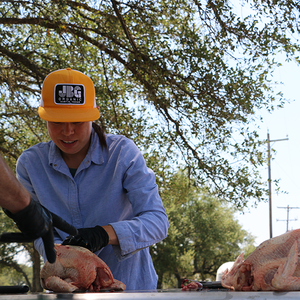Last Saturday, we hosted our first public event at ROAM Ranch. Co-founders Katie and Taylor purchased this 450 aces on the outskirts of Fredericksburg just over a year ago, thrilled to bring the EPIC mission alive on their own land. The land had been intensively farmed for decades, left in a desolate state with widespread bare soil and erosion. The vision of ROAM is to demonstrate the power of regenerative agriculture to restore soil, water, and wildlife. Educational events like this one are a huge component of the community involvement required for real change.
In a tour led by Katie, Taylor, and COO Robby, the fourteen event attendees got a taste of the impact regenerative agriculture can have on degraded land—even in just one year! We started off examining the soil in different areas of the land, and it was clear that the soil that had time to rest followed by bison introduction was much better off.

“Our biggest opportunity to reverse climate change is through building thriving grasslands,” Taylor explained. “In fact, grasslands are the most effective means at removing carbon from the atmosphere and, through photosynthesis, can store that carbon deep into the soil where it serves to feed valuable microorganisms and increases the porosity of the ground. It is impossible to have healthy and thriving grasslands without ruminant animals. So if we want to utilize our best tool for sequestering carbon, we need ruminates on pasture, acting as the catalyst for a functioning ecosystem.”
Planned grazing is one of many methods advocated for by the Savory Institute that Katie and Taylor have thoughtfully implemented on ROAM. Put simply, they monitor the amount of time the bison spend on any given plot of pasture to prevent overgrazing. By allowing the land to rest in between grazing, the plants can recover, preventing nutrient depletion. At the same time, the impact of hooves from concentrated herds of bison encourages decomposition and stimulates nutrient cycling.

We then hopped back into our eclectic vehicles to ride to the apiary, where 200,000 honeybees reside. Taylor explained that, due to colony collapse disorder, they are losing about 50 percent of the colony each year. Pesticides are a huge disruptor to bees’ nervous systems, so they hope that the bee populations will start to stabilize with the newly-implemented holistic land management.
After journeying across the grassland right up to a herd of the 70 bison they recently introduced to the land, Katie jumped out of the driver’s seat with her one-year-old daughter in tow to greet them. We were quickly surrounded by the herd, who were shedding large clumps of hair to make room for a new fall coat. I felt a sense of awe as I sensed the young herd’s connection to the land that is being restored through regenerative agriculture, which promotes their natural way of living.

After spending time with the bison, we were off to the mobile chicken coops to get to know the birds. The enclosure houses chickens, ducks, and turkeys away from predators. Solar-powered panels open with the sunrise and close around sundown. During the day, the bids roam freely on the open grasslands, munching on bugs and plants along their way. Taylor and Katie were proud to show their guests how these animals were raised, especially since they would be sacrificing their lives for food in the same visit.
Eventually, some of these birds will follow the bison herd, mimicking the relationship between predators and prey on which these environments evolved. According to the Savory Institute, a properly-managed poultry operation can create a favorable “flock effect” by scratching and pecking the top quarter inch of soil, effectively preparing the seedbed for a smoother and higher distribution of seeds. Due to the inclusion of feed and high-protein bugs in their diets, pastured poultry also provides another powerful round of fertilization different than that from the bison. Furthermore, pastured chickens can help as natural insecticides, eating flies and parasites that often plague livestock. After the herd effect from the bison and flock effect from pastured chickens, the grass is left primed for re-growth.

The chicken harvest and butchery was a solemn yet sacred experience. A professional butcher showed the group how to humanely harvest and safely butcher a chicken before each participant got to go through the process with careful assistance. The ROAM employee who raised the chickens thanked all participants for their thoughtfulness and willingness to connect with these birds that he had come to love. Because of the respect for these chickens and the environment we all shared, it was an unspoken privilege to ensure that these chickens die with honor and not suffering.
By connecting with their food, visitors left with a newfound respect for holistic land management. Attendee and holistic nutritionist Carly Johnson Brawner said afterwards, “I feel proud to take part in preparing the food I am going to consume. So many of us are so far removed from the food we eat—it feels right to be involved in the process for once.”

“[I’m] feeling inspired by EPIC Bar’s vision, passion, and knowledge about regenerative agriculture,” she continued. “They bought a degenerated farm to experiment and learn what it takes to bring healthy soils and flourishing ecosystems back to land. This is not ‘just farming’ or ‘organic farming’—it’s so much more, and our future depends on it.”
Teaching these visitors how to harvest their own meat is an exciting first step in the education Taylor and Katie hope to continue at ROAM. In fact, it was such a success that will be hosting another chicken harvest this August! Let us know in the comments if you are interested in other specific topics or activities surrounding holistic land management.

Sources:
The Savory Institute: https://www.savory.global/



